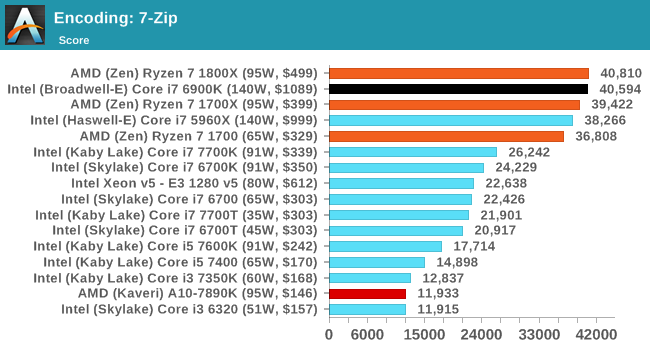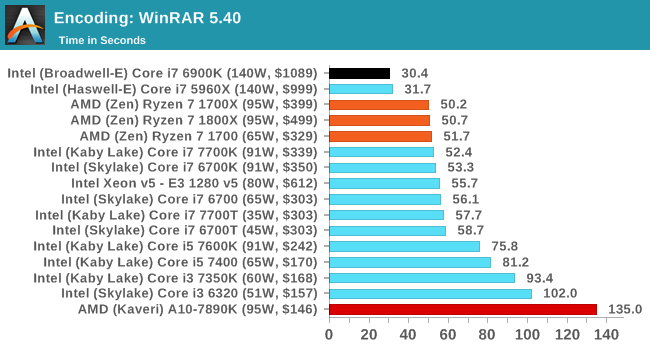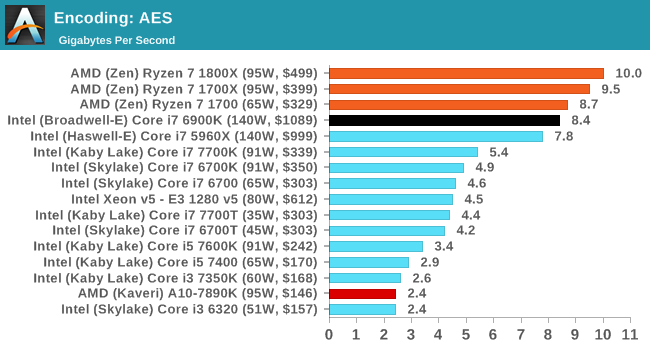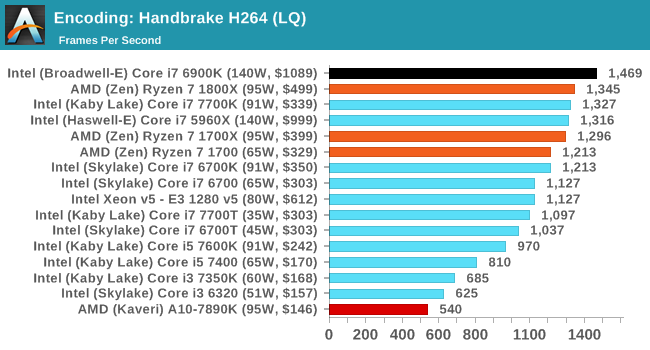The AMD Zen and Ryzen 7 Review: A Deep Dive on 1800X, 1700X and 1700
by Ian Cutress on March 2, 2017 9:00 AM ESTBenchmarking Performance: CPU Encoding Tests
One of the interesting elements on modern processors is encoding performance. This includes encryption/decryption, as well as video transcoding from one video format to another. In the encrypt/decrypt scenario, this remains pertinent to on-the-fly encryption of sensitive data - a process by which more modern devices are leaning to for software security. Video transcoding as a tool to adjust the quality, file size and resolution of a video file has boomed in recent years, such as providing the optimum video for devices before consumption, or for game streamers who are wanting to upload the output from their video camera in real-time. As we move into live 3D video, this task will only get more strenuous, and it turns out that the performance of certain algorithms is a function of the input/output of the content.
7-Zip
One of the freeware compression tools that offers good scaling performance between processors is 7-Zip. It runs under an open-source licence, is fast, and easy to use tool for power users. We run the benchmark mode via the command line for four loops and take the output score.

WinRAR 5.40
For the 2017 test suite, we move to the latest version of WinRAR in our compression test. WinRAR in some quarters is more user friendly that 7-Zip, hence its inclusion. Rather than use a benchmark mode as we did with 7-Zip, here we take a set of files representative of a generic stack (33 video files in 1.37 GB, 2834 smaller website files in 370 folders in 150 MB) of compressible and incompressible formats. The results shown are the time taken to encode the file. Due to DRAM caching, we run the test 10 times and take the average of the last five runs when the benchmark is in a steady state.

AES Encoding
Algorithms using AES coding have spread far and wide as a ubiquitous tool for encryption. Again, this is another CPU limited test, and modern CPUs have special AES pathways to accelerate their performance. We often see scaling in both frequency and cores with this benchmark. We use the latest version of TrueCrypt and run its benchmark mode over 1GB of in-DRAM data. Results shown are the GB/s average of encryption and decryption.

HandBrake H264 and HEVC
As mentioned above, video transcoding (both encode and decode) is a hot topic in performance metrics as more and more content is being created. First consideration is the standard in which the video is encoded, which can be lossless or lossy, trade performance for file-size, trade quality for file-size, or all of the above can increase encoding rates to help accelerate decoding rates. Alongside Google's favorite codec, VP9, there are two others that are taking hold: H264, the older codec, is practically everywhere and is designed to be optimized for 1080p video, and HEVC (or H265) that is aimed to provide the same quality as H264 but at a lower file-size (or better quality for the same size). HEVC is important as 4K is streamed over the air, meaning less bits need to be transferred for the same quality content.
Handbrake is a favored tool for transcoding, and so our test regime takes care of three areas.
Low Quality/Resolution H264: He we transcode a 640x266 H264 rip of a 2 hour film, and change the encoding from Main profile to High profile, using the very-fast preset.

High Quality/Resolution H264: A similar test, but this time we take a ten-minute double 4K (3840x4320) file running at 60 Hz and transcode from Main to High, using the very-fast preset.

HEVC Test: Using the same video in HQ, we change the resolution and codec of the original video from 4K60 in H264 into 1080p30 HEVC. This causes a dramatic reduction in filesize.











574 Comments
View All Comments
EchoWars - Thursday, March 2, 2017 - link
No, apparently the failure was in your education, since it's obvious you did not read the article.Notmyusualid - Friday, March 3, 2017 - link
Ha...sharath.naik - Thursday, March 2, 2017 - link
I think you missed the biggest news in this information dump. The TDP is the biggest advantage amd has. Which means that for 150watt server cpu. they should be able to cram a lot more cores than intel will be able to.Meteor2 - Friday, March 3, 2017 - link
^^^This. I think AMD's strength with Zen is going to be in servers.Sttm - Friday, March 3, 2017 - link
Yeah I can see that.UpSpin - Thursday, March 2, 2017 - link
According to a german site, in games, Ryzen is equal (sometimes higher, sometimes lower) to the Intel i7-6900K in high resolution games (WQHD). Once the resolution is set very low (720p) the Ryzen gets beaten by the Intel processor, but honestly, who cares about low resolution? For games, the probably best bet would be the i7-7700K, mainly because of the higher clock rate, for now. Once the games get better optimized for 8 cores, the 4-core i7-7700K will be beaten for sure, because in multi-threaded applications Ryzen is on par with the twice expensive Intel processor.I doubt it makes sense to buy the Core i7-6850K, it has the same low turbo boost frequency the 6900K has, thus low single threaded performance, but at only 6 cores. So I expect that it's the worst from both worlds. Poor multi-threaded performance compared to Ryzen, poor single threaded performance compared to i7-7700K.
We also have to see how well Ryzen can get overclocked, thus improving single core performance.
fanofanand - Thursday, March 2, 2017 - link
That is a well reasoned comment. Kudos!ShieTar - Thursday, March 2, 2017 - link
Well, the point of low-resolution testing is, that at normal resolutions you will always be GPU-restricted. So not only Ryzen and the i7-6900K are equal in this test, but so are all other modern and half-modern CPUs including any old FX-8...The most interesting question will be how Ryzen performs on those few modern games which manage to be CPU-restricted even in relevant resolutions, e.g. Battlefield 1 Multiplayer. But I think it will be a few more days, if not weeks, until we get that kind of in-depth review.
FriendlyUser - Thursday, March 2, 2017 - link
This is true, but at the same time this artificially magnifies the differences one is going to notice in a real-world scenario. I saw reviews with a Titan X at 1080p, while many will be playing 1440p with a 1060 or RX480.The test case must also approximate real life.
khanikun - Friday, March 3, 2017 - link
They aren't testing to show what it's like in real life though. The point of testing is to show the difference between the CPUs. Hence why they are gearing their benchmarking to stress the CPU, not other portions of the system.